Hybrid Events: A Complete Guide for 2024
Read Time: 14 minutes
Posted on August 1, 2023

This comprehensive guide on hybrid events gives you a clear understanding of this wide field, along with practical planning and management tips, effective marketing strategies, and inspiring examples to enhance your next event.
As hybrid events continue to shape the future of conferences, trade shows, and corporate gatherings, understanding how to leverage in-person and virtual elements is crucial for success.
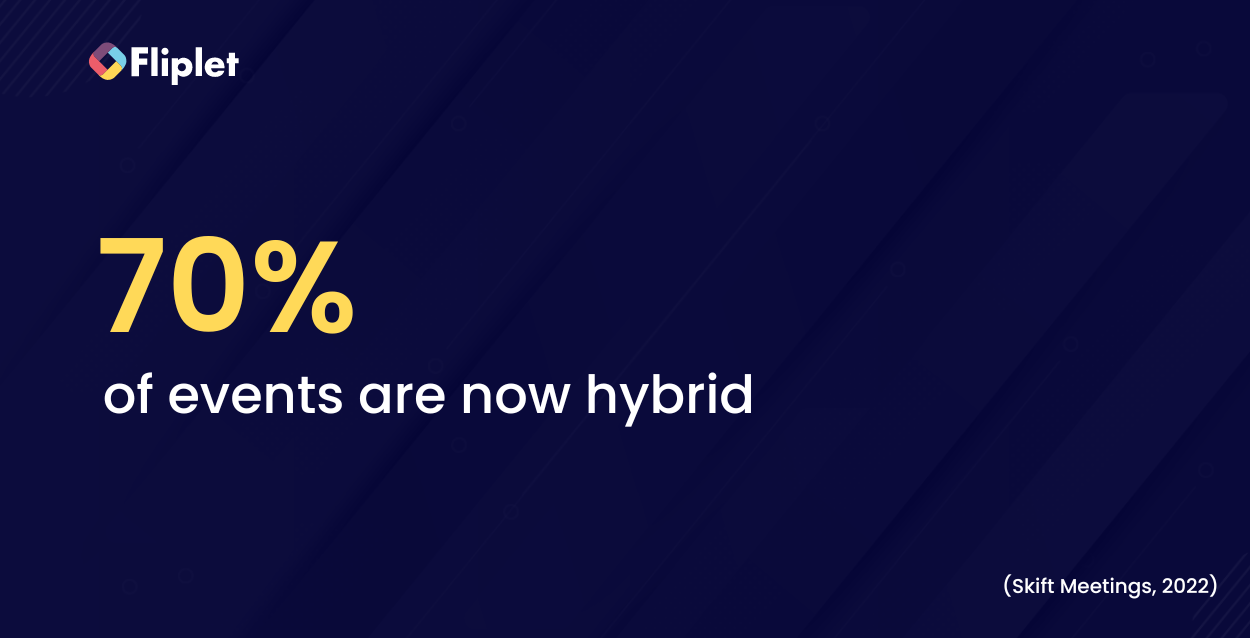
Below, we explore the benefits and growing popularity of hybrid events to equip event organizers with actionable insights to optimize these versatile engagements in 2024 and beyond.
What is a hybrid event?
The hybrid events model is a powerful combination of in-person and virtual attendance, allowing participants to engage from anywhere globally. This isn’t a new phenomenon; Apple’s WWDC (Worldwide Developers Conference) is a prime example of a hybrid event that has been functioning for years.
The rise & popularity of hybrid meetings and events

Emphasizing the longevity of hybrid events, let’s understand that they aren’t a nascent concept. Apple, for instance, hosted its first hybrid event long before the term was coined. The tech behemoth’s keynote addresses, product launches, and workshops have been accessed by attendees physically and virtually, making it a paradigmatic hybrid events example.
The rise in popularity of hybrid events isn’t surprising. The global pandemic propelled a swift transition to digital platforms. However, the benefits of hybrid events – wider reach, flexibility, inclusivity, and cost-effectiveness – have contributed to their sustained prevalence. As per a recent report by EventMB, hybrid events saw a 250% increase in 2021, underlining their ever-growing appeal.
Another report from Bizzabo reveals that 68% of event professionals are looking for hybrid event technology that supports both in-person and virtual events, highlighting the increasing reliance on hybrid models.
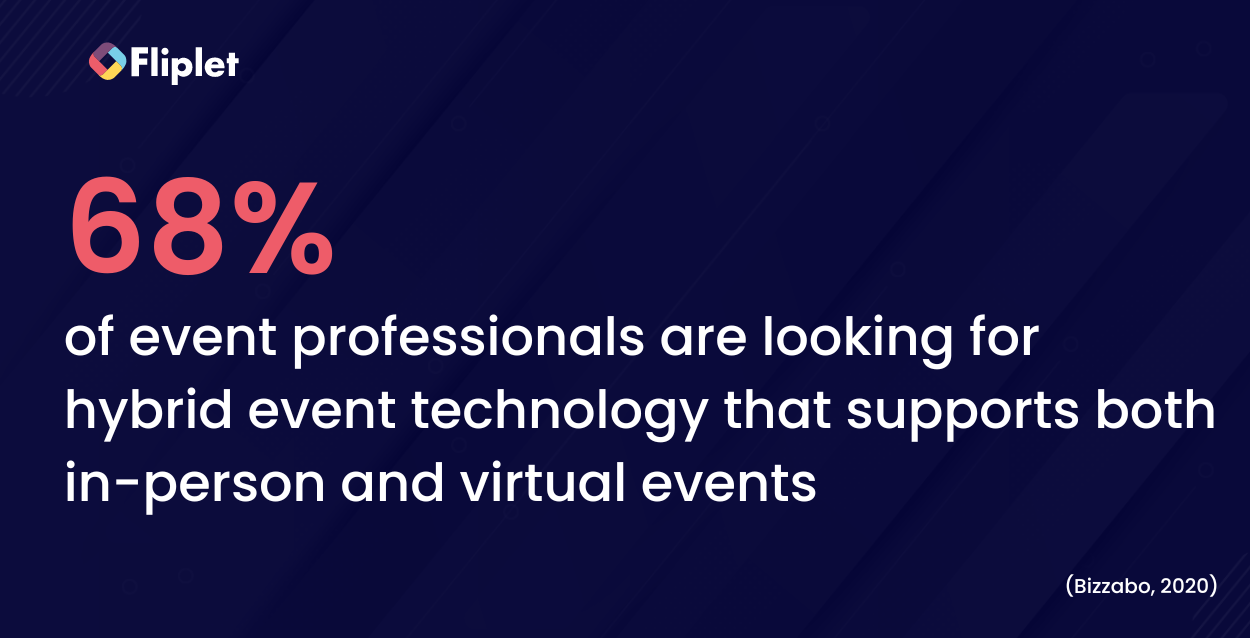
Hybrid Events and How They Fit in Your Event Strategy
If you haven’t yet considered incorporating hybrid events into your strategy, now is time to do so. The upward trajectory of hybrid events doesn’t seem to be slowing down anytime soon. As their influence continues to expand, creating a robust case for their integration into your event strategy.
In-Person Events vs. Hybrid Events
- Attendance limits: In-person events are constrained by venue capacity, whereas hybrid events can expand audience reach by incorporating virtual attendees.
- Engagement opportunities: Hybrid events offer both traditional in-person engagement and digital tools like live polls and chat, enhancing interactivity across both platforms.
- Cost efficiency: Hosting an event physically can be costly due to venue, logistics, and travel expenses. Hybrid events can reduce these costs by accommodating some attendees virtually.
- Accessibility: Hybrid events make it possible for attendees who cannot travel due to budget, health, or scheduling conflicts to participate online.
- Environmental impact: Reducing the number of in-person attendees can lower the carbon footprint associated with travel and venue resource use.
- Flexibility: Hybrid events provide a safety net. If physical gathering becomes impractical, the event can still proceed virtually.
Virtual Events vs. Hybrid Events
- Experience depth: Virtual events limit the sensory experience to what can be presented on a screen, while hybrid events offer a physical dimension for onsite attendees, enhancing the overall experience.
- Networking quality: Hybrid events allow for face-to-face networking opportunities which are often more impactful and memorable compared to virtual-only networking sessions.
- Technical demands: Virtual events primarily rely on robust internet connectivity and streaming services. Hybrid events, however, require managing both live event production and virtual streaming, potentially increasing complexity.
- Participant engagement: Engaging virtual participants can be more challenging due to distractions and screen fatigue. Hybrid events mitigate this by engaging in-person audiences, whose reactions can also energize the virtual audience.
- Content delivery: Hybrid events provide flexibility in content delivery, allowing presentations to be experienced live or viewed later, catering to different time zones and schedules.
- Event resilience: Hybrid events are more adaptable to changing circumstances, such as health advisories or travel restrictions, ensuring the event can proceed with virtual components if in-person aspects are impacted.
When to host hybrid events
When should you host a hybrid event? The answer is – anytime and anyplace. Hybrid events are not confined to a specific industry or event type. Whether you’re hosting a corporate conference, orchestrating a product launch, managing a fundraiser, or planning an academic seminar, hybrid events serve as a flexible and inclusive platform. They enable you to engage with a diverse audience across various geographical locations, eliminating the boundaries imposed by traditional in-person events.
The versatility of hybrid events makes them particularly attractive when traditional, in-person attendance isn’t possible. Here are some circumstances where attendees, who would usually be present on-site, might need to participate virtually:
- The attendee might be unable or unwilling to travel due to personal reasons or global circumstances like a pandemic.
- Budget constraints within the attendee’s organization could limit travel expenses, preventing them from physically attending the event.
- Physical venues often have capacity or accessibility limitations, prohibiting all attendees from gathering on-site.
Given these potential situations, it’s advisable to engage with your invitees before the event. Sending out a pre-event survey can help understand the preferences and restrictions of your attendees. If the feedback indicates a significant number who prefer or are only able to attend virtually, a hybrid event could be the most suitable approach. This way, you ensure inclusivity and participation, regardless of the circumstances, enhancing the popularity and demand for hybrid events.
Read this case study to see how a Top 30 UK Law firm switched from another solution to Fliplet and went from 40 minutes inputting the details for an event to getting an event live in the app in just 10-15 minutes.
For more on this from Fliplet, read our events budget template.
The 4 Pillars of Hybrid Events: Core Elements, Goals, Benefits, and Advantages
Understanding the four pillars of hybrid events is vital to harnessing their potential fully. These pillars – core elements, goals, benefits, and advantages – shape the framework of successful hybrid events.
Core Elements
The core elements of hybrid events encompass the live audience, virtual participants, content delivery, engagement tools, and the hybrid events platform. Selecting the right hybrid events software, such as Fliplet’s Event solution, is crucial to seamless execution. A reliable hybrid events platform can be fundamental to the seamless execution and success of the event.
Goals
The goals of hybrid events vary according to the event type but typically include expanding reach, driving engagement, promoting inclusivity, and boosting ROI. Clear, measurable, and realistic goal setting contributes to an increase in event effectiveness. 60% of event managers believe that events are the most critical marketing channel for achieving business goals (Bizzabo, 2023). By defining and tracking your objectives, you can optimize your event strategy to deliver impactful experiences and meet your business goals.
Benefits of hybrid events
The benefits of hybrid events are manifold. They promote accessibility and inclusivity by enabling participation from anywhere in the world. Gartner’s research reveals that hybrid events can improve attendance rates by 50% due to their flexible format. Additionally, these events provide valuable data analytics, generate diverse revenue streams, and are environmentally friendly – a factor highlighted by Event Manager blog, stating that hybrid events can reduce the carbon footprint by up to 70%. Take a look at the benefits of Fliplets event solution:
Hybrid events offer numerous benefits to organizers. They allow you to increase your reach beyond geographical constraints, providing an opportunity to connect with a global audience. Furthermore, they offer valuable data insights, which can help you understand attendee behavior and improve future events. Hybrid events also offer a safety net in times of uncertainty, like during a pandemic, allowing for flexibility in format changes.
Advantages of hybrid events
Hybrid events carry a wealth of advantages. They facilitate wider reach, greater engagement, and cost-effectiveness. Bizzabo’s report suggests that hybrid events can extend audience reach by up to 3 times compared to traditional in-person events. They also foster high levels of engagement as hybrid events increase in attendee interaction in hybrid events.
Research also suggests 68.7% of event professionals agree that using technology to improve the attendee experience is a trend with staying power (Knowland, 2022). Lastly, hybrid events provide a safety net in uncertain times, allowing organizers to switch formats effortlessly if required, thereby ensuring event continuity and minimizing financial risk.

Goldcast discovered on average, hybrid event participants attend 44% of the virtual event and 56% of the in-person event. In other words, if you just provide one sort of event, you’ll lose around 50% of the people who may come. More people can attend hybrid events because to their versatility. You can invite as many people as you wish to strengthen the list of participants on the actual event day by significantly increasing the number of pre-event registrations.
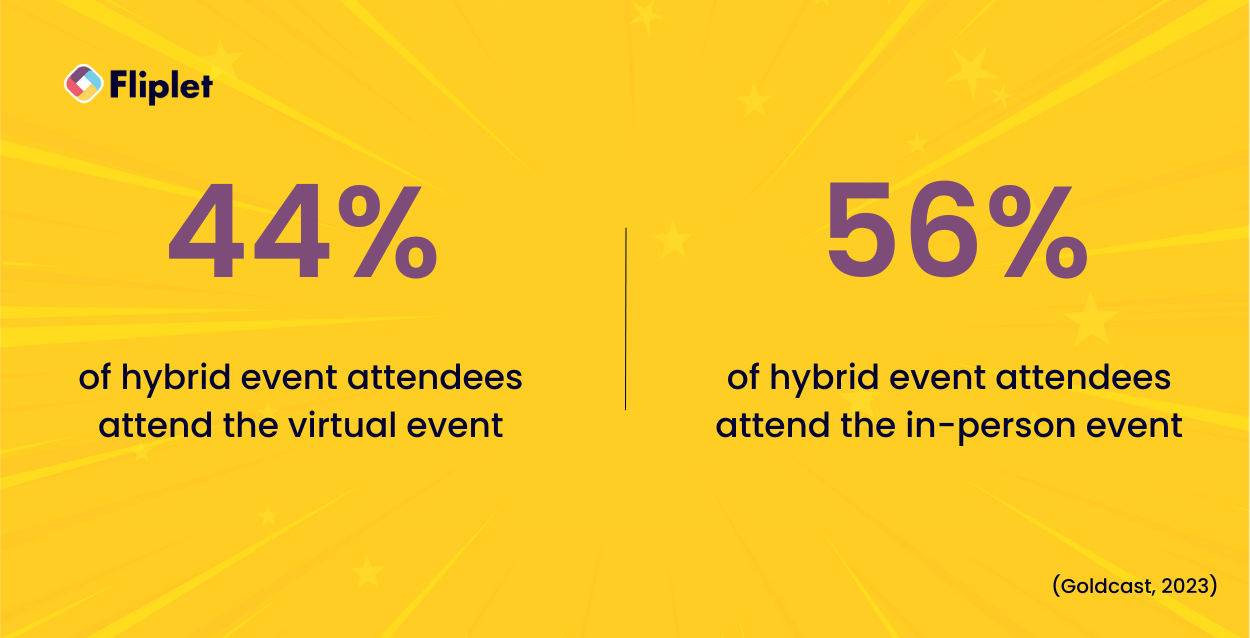
But the benefits of hybrid events go far beyond breaking physical barriers. By combining the intimacy of in-person interaction with the reach of digital platforms, hybrid events promise a richer, more immersive experience for attendees. Hybrid events can increase attendance and add to organizations value proposition.
Furthermore, hybrid events drive tangible ROI. According to Markletic, 89% of hybrid events return a positive return on investment (ROI) for B2B companies after only 7 months thanks to additional income streams like digital ticket sales, virtual sponsorship packages, and wider reach. Plus, they provide invaluable data analytics that can help you measure event success and inform future strategies. To help get you started take a look at the top 10 best app builder to create a mobile app.
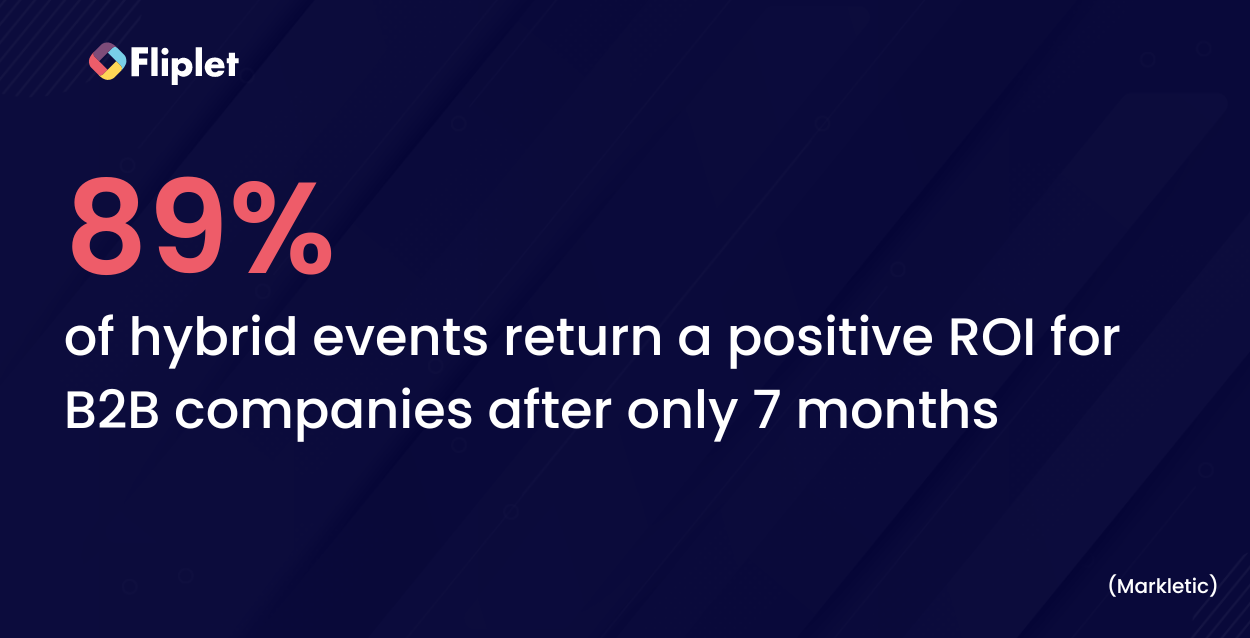
In an era where adaptability, inclusivity, and innovation are key, hybrid events stand as a robust solution to evolving audience needs and expectations. As an event organizer or manager, embracing hybrid events means staying ahead of the curve, expanding your reach, and driving better results.
Comparatively, hybrid events offer a unique blend of features not found in in-person or virtual events alone. They combine the vibrancy and networking opportunities of in-person events with the accessibility and convenience of virtual ones.
Types of hybrid events
Understanding the types of hybrid events is integral to their successful implementation. Depending on the target audience, these can be categorized as internal or external hybrid events.
Internal Hybrid Events
These events primarily cater to your organization’s internal stakeholders such as employees, leadership team, and staff. Given the challenge of gathering all internal stakeholders in a single location, hybrid events offer an effective solution. You can organize the event at a central location, such as your company headquarters, and live stream it to the rest of the organization.
Some common examples of internal hybrid events include:
- Sales Kickoffs
- Global Town Halls
- Larger Team Meetings
- Company Spirit Weeks
- Corporate Events
External Hybrid Events
External events target customers, prospects, and clients. Transitioning your live external events to a hybrid format can significantly increase attendance and reduce your event’s carbon footprint.
Here are some types of external events that are often adapted into hybrid format:
- Conferences and Trade Shows – read this case study to see how this leading International law firm managed to customize an app for events and successfully changed the experience of conferences.
- Customer Conferences
- Product Demonstrations
By differentiating between internal and external hybrid events, you can better tailor your event strategies to meet your specific audience needs.
Hybrid Event Examples & Ideas
Exploring different formats and setups can inspire your next hybrid event. Below are examples of various hybrid event types, each demonstrating how combining physical presence with virtual elements can create a dynamic and inclusive experience.
Hybrid conference
A hybrid conference involves live sessions, keynote speeches, and panel discussions that are accessible both in-person and online. This format not only extends the reach to a global audience but also incorporates interactive elements like real-time Q&A sessions, polls, and networking opportunities across both platforms.
Example: A global tech conference integrates live keynotes with simultaneous virtual discussions, extending interaction beyond geographical limits.
Hybrid Career Fair
Hybrid career fairs allow employers and job seekers to engage both on-site and virtually. Employers can set up physical booths and virtual profiles, conducting live interviews and presentations in both formats. This setup broadens access to potential hires from different geographical locations, while also catering to local attendees who prefer personal interaction.
Example: Universities and major corporations collaborate to host career fairs where attendees connect with recruiters through both in-person interviews and virtual chat rooms.
Hybrid trade show
Trade shows that incorporate hybrid elements can host exhibitors and attendees physically and virtually. Virtual attendees can tour booths through 3D walkthroughs and participate in live-streamed product demos. This model amplifies reach and interaction, allowing exhibitors to connect with a broader audience and gather more leads than a traditional in-person event.
Example: An auto industry trade show features onsite vehicle displays and virtual reality tours, allowing global attendees to experience new models remotely.
Hybrid Presentation
Presentations at hybrid events can be designed to captivate both live and online audiences simultaneously. By utilizing dual screens, interactive tools, and live feedback mechanisms, presenters can effectively engage participants from all venues. An example is a product launch where the presentation is live-streamed, and remote viewers can participate in real-time feedback and Q&A sessions.
Example: A marketing firm launches its latest strategy through a hybrid presentation, enabling attendees to interact via live polls and questions whether they’re in the room or online.
Hybrid Exhibition
Hybrid exhibitions integrate physical displays with virtual tours and interactive digital content. Art galleries, museums, and trade exhibitions can use this model to enhance visitor experiences by offering virtual reality (VR) experiences, online galleries, and live artist talks, thus reaching art lovers who cannot attend in person.
Example: An art exhibition offers virtual reality walkthroughs of physical galleries, enabling art enthusiasts worldwide to explore and purchase artworks.
Hybrid seminar
Seminars that adopt a hybrid format benefit from the academic rigor of in-person discussions combined with the broad accessibility of online participation. This setup is ideal for educational institutions and professional development programs aiming to extend learning opportunities beyond their physical confines.
Example: A professional development seminar on digital marketing offers live sessions for local attendees and webinars for international participants, complete with interactive Q&A segments.
Hybrid Networking Event
Networking is crucial in many professional settings. A hybrid networking event can facilitate connections via speed networking sessions on-site, complemented by virtual “rooms” where online participants can join discussions and meet new contacts. This method ensures that all participants, regardless of their location, can forge meaningful professional relationships.
Example: A business networking event uses a platform that blends in-person mingling with virtual breakout sessions, maximizing professional connection opportunities.
Hybrid Corporate Events
Corporate events, including annual meetings, product launches, and training sessions, can be executed as hybrid events to include employees who work remotely or in different global offices. This approach not only reinforces company culture but also ensures inclusivity, allowing every team member to participate and engage with the content and each other, regardless of their physical location.
Example: A multinational company conducts its annual general meeting as a hybrid event, allowing employees worldwide to participate in real-time corporate updates and strategic discussions.
10 Tips for Successful Hybrid Event Planning
Creating a successful hybrid event requires careful planning and execution. Here are ten tips
1.Gamification
Gamification is a powerful tool for driving attendee engagement in hybrid events. According to Pavegen, gamification can boost audience interaction by up to 48%. This could involve incorporating elements like polls, quizzes, interactive challenges, or leaderboards into your event. For example, you could host a virtual webinar, rewarding participants with points, and certificates for participating in polls and quizzes. This creates a fun, competitive atmosphere that encourages active participation and enhances the attendee experience.
2.Hybrid Event Platform
The success of your hybrid event largely depends on the software you choose. The right hybrid events platform ensures a seamless, interactive experience for both online and in-person attendees. Fliplet’s Event solution, renowned for its ease of use due to being able to create a mobile or web app for all your events, hybrid, virtual and in-person, making it a reliable choice.
Fliplet’s Event solution includes key features you need to make your hybrid event a success such as, agenda, floorplan, chat, networking, Q&A, directory of speakers and attendees, gamification, polls, surveys, quizzes – the list continues. The solution also supports live streaming, networking and real-time analytics, enabling you to deliver a high-quality, engaging event.
With Fliplet, you can build your hybrid event app in just 15 minutes, take a look:
3.Mobile App
88% of event-planning professionals agree that event apps helped get a better satisfaction level out of attendees, this could be a mobile app, web app or both. This comes as no surprise, considering the plethora of benefits a dedicated event app provides. It enhances the attendee experience by providing easy access to event schedules, speaker profiles, networking opportunities, and more. Moreover, it allows attendees to participate in polls, surveys, and live discussions, significantly boosting engagement levels. Take a look at the top 16 features of a successful mobile app.
With Statista predicting that mobile apps will generate over $935 billion in revenue by 2023, it’s clear that this trend isn’t slowing down anytime soon. Therefore, integrating a mobile app into your hybrid event strategy is a must.
Download Fliplet’s Event Brochure for free
4.Content
Content is the backbone of your hybrid event. The quality of your content significantly influences audience engagement and satisfaction. It’s crucial to curate informative, relevant, and captivating content that appeals to both your in-person and virtual attendees. Keep in mind that content doesn’t just mean presentations or speeches; it also includes videos, infographics, blog posts, whitepapers, and other resources related to your event’s theme.
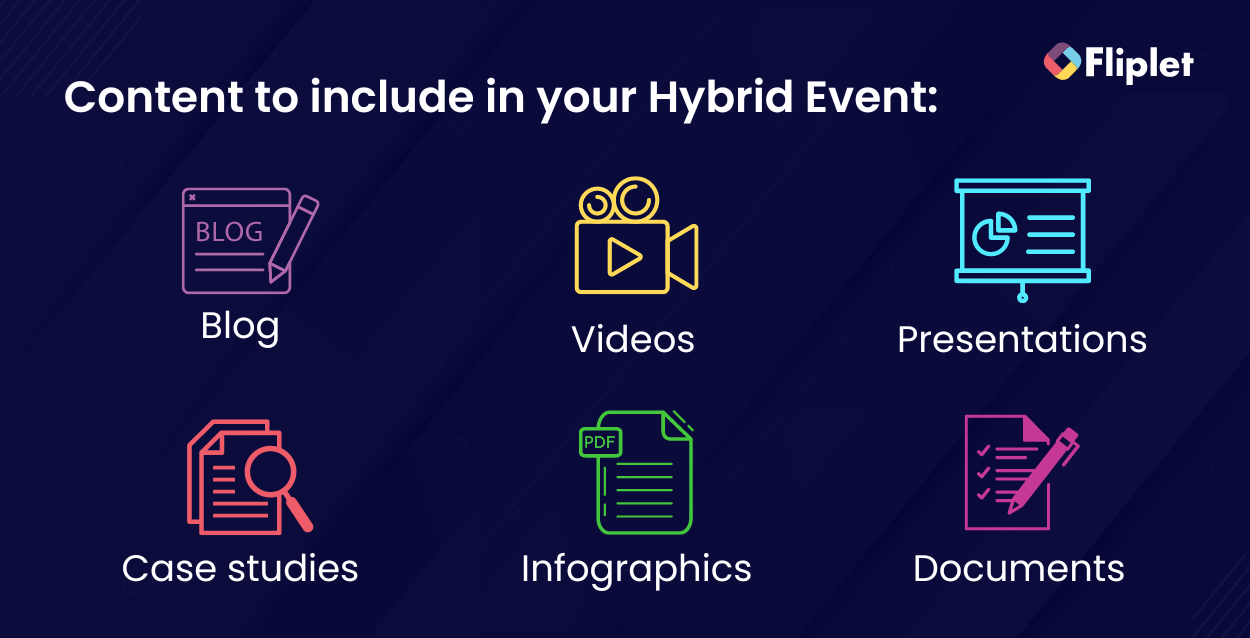
5.Community
Building a community around your event can increase attendee engagement and foster a sense of belonging. You can leverage social media platforms, forums, and the event app to facilitate discussions, share updates, and encourage networking. According to a study by the Community Roundtable, 88% of communities impact member engagement positively, proving its importance in creating a successful hybrid event.
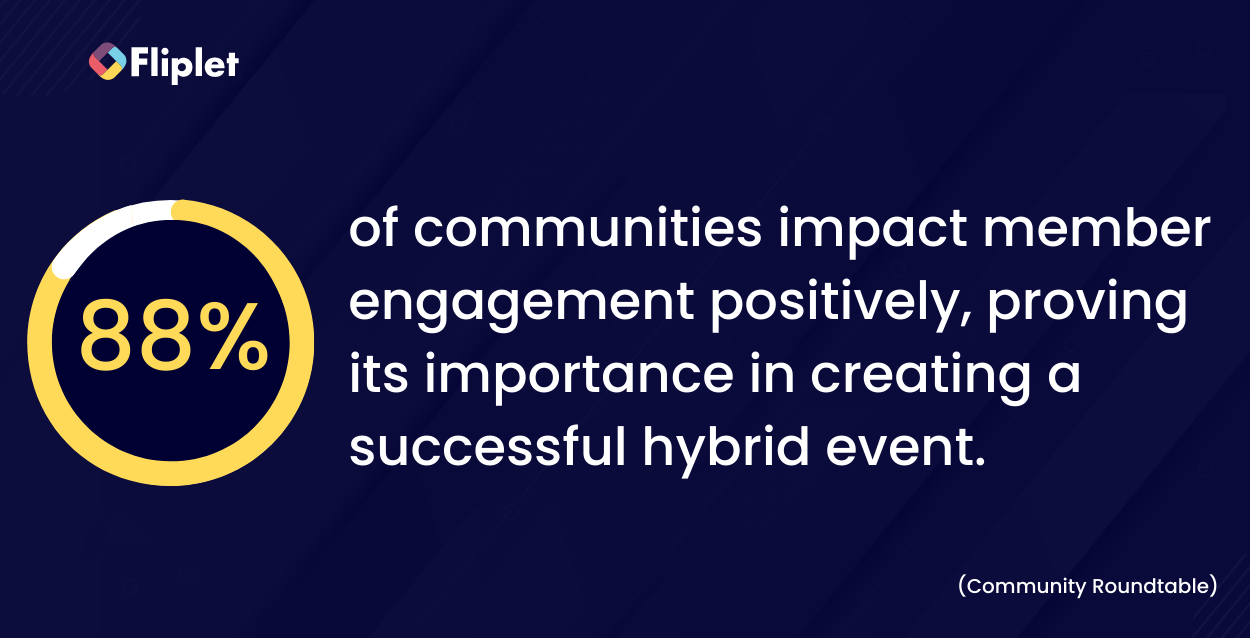
6.Sponsors
Sponsors play a critical role in supplementing your event budget and providing added value for attendees. However, securing sponsorships for hybrid events requires a shift in strategy. Virtual sponsor booths, sponsored sessions, branded games, or digital ads are excellent ways to offer value to sponsors. Remember to clearly communicate the benefits sponsors can expect, such as brand exposure, lead generation, and networking opportunities.

7.Analytics
With hybrid events, you have access to a wealth of data that can provide valuable insights into attendee behavior and preferences. Platforms like Fliplet provide real-time analytics that allow you to track participant engagement, attendance, session popularity, and more. Using this data, you can continually optimize your event for better results.
8.Calculate Your Cost & ROI
Understanding your expenses and potential returns is fundamental to successful event planning. Hybrid events typically involve costs related to the venue, technology, promotion, and personnel. Simultaneously, they can generate revenue through ticket sales, sponsorships, and merchandise. By calculating these figures, you can set realistic budgets, pricing strategies, and measure your event’s ROI accurately.
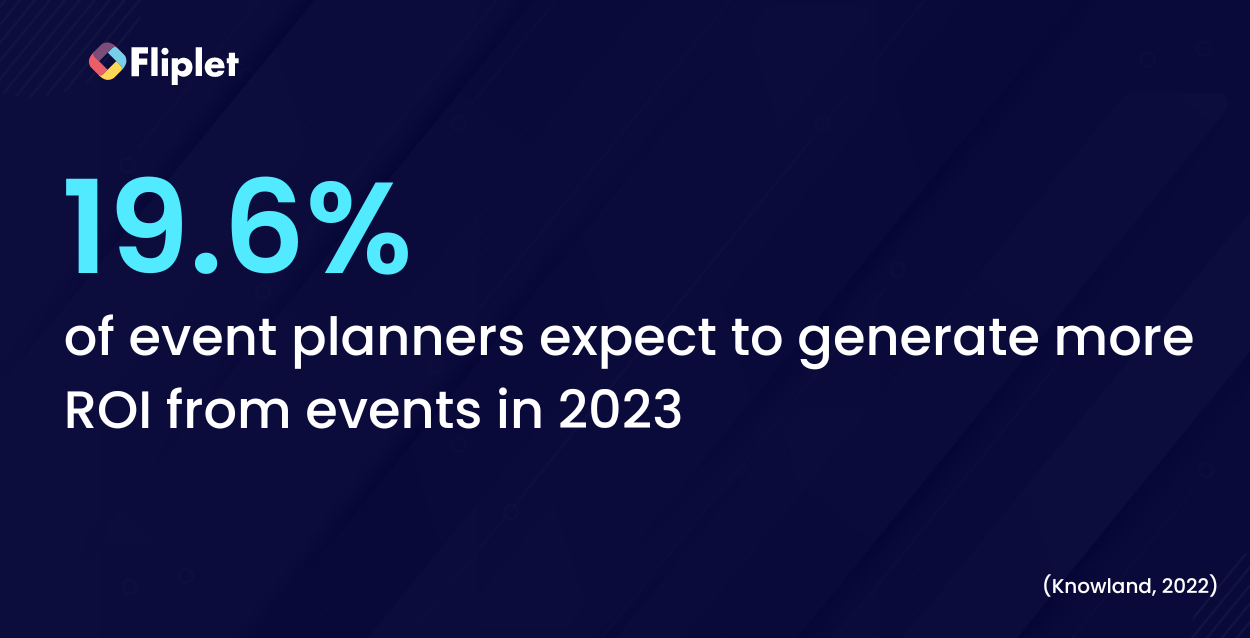
9.Ensure Technical Reliability
Nothing disrupts a hybrid event like technical glitches. Ensure that your internet connection is reliable, the audio-visual quality is top-notch, and the event platform or app is robust and user-friendly. A study by AMEX found 6 out of 10 organizers said their biggest challenges were lack of knowledge/experience with virtual tech & technical issues. Hence, it’s advisable to run some tests beforehand.

10.Design a Seamless Attendee Journey
From the registration process to post-event follow-ups, each touchpoint of your attendee journey should be meticulously planned for both in-person and virtual participants. This includes easy registration, clear communication, interactive sessions, networking opportunities, and valuable resources. A well-designed attendee journey not only improves the event experience but also boosts attendee retention rates.
According to Bizzabo, 75% of marketers believe attendee experience is crucial for event success. It’s important to remember here the attendee journey does not finish when the event ends, think about the journey you want them to take after the event as well.
Watch this demo of Fliplet’s Event solution:
Pro Tips & Best Practices for Hosting Hybrid Events
The best practices for hybrid events include setting clear, measurable goals, choosing the right hybrid events platform, creating engaging content for both in-person and virtual attendees, utilizing a mobile app, leveraging the power of analytics, and effectively calculating costs and ROI. Each of these elements plays a vital role in the overall success of your hybrid event.
Balancing the needs of in-person and virtual attendees can be challenging. Here are some pro tips to help you deliver an exceptional hybrid event.
- Find the right balance: Engage both online and in-person attendees by delivering interactive, accessible content.
- Invest in reliable technology: Ensure a seamless experience by investing in reliable hybrid events technology and providing technical support. Read reviews and try the free version to ensure it meets your needs.
- Offer on-demand content: Provide recorded sessions for attendees in different time zones or those who wish to revisit the content. This also links to our tip number 10, designing a seamless attendee journey. Email attendees and those that couldn’t attend the content after the event has happened.
- Maximize networking opportunities: Facilitate networking through breakout sessions, Q&As, and virtual meet-ups.
- Train your team: Make sure your team is well-versed in managing both aspects of your hybrid event.
Checklist for successful hybrid events
Creating a successful hybrid event involves numerous tasks. Here’s a handy checklist to guide you:
- Define your goals
- Select a suitable hybrid events platform
- Plan engaging, accessible content
- Incorporate interactive elements like polls and quizzes
- Secure sponsors
- Leverage analytics to track performance
- Calculate costs and ROI
- Design an engaging attendee journey
Download the Ultimate Checklist to get you started
Hybrid event technology
More than other kinds, hybrid events rely on the right technology because those tools are required for seamlessly merging in-person and virtual experiences.
Hybrid event technology facilitates this integration, ensuring that both attendees and organizers have a smooth and engaging experience. Here’s how advanced tools and platforms are revolutionizing the field:
- Custom event apps: Utilizing no-code app builders, organizers can create tailored mobile applications that enable participants to access event schedules, network with others, and interact with content, all from their smartphones. This technology empowers event planners to update information in real time and gather attendee feedback efficiently.
- Interactive features: Technologies such as live polling, real-time Q&A, and virtual breakout rooms enhance interaction, making attendees part of the conversation, whether they are on-site or joining remotely.
- Streaming solutions: Reliable live streaming services are essential for broadcasting high-quality video and audio to virtual attendees, ensuring everyone partakes in the live event experience without technical glitches.
- Integration systems: Integrating the event management software with CRM systems, social platforms, and other digital tools helps in creating a cohesive ecosystem that enhances attendee engagement and streamlines administrative workflows.
- Analytics tools: Post-event analytics offer valuable insights into attendee behavior, engagement levels, and overall event success, helping organizers refine their strategies for future events.
Hybrid event technology not only simplifies the management and execution of hybrid events but also enhances the overall attendee experience by making events more accessible, interactive, and measurable.
Build your hybrid event app with a no-code app builder






Hybrid event management
Orchestrating a successful hybrid event can be challenging if you are not prepared or have everything in place to help your event be a success. You need to create an agenda that appeals to both in-person and virtual attendees, ensuring an immersive and effective program. As you sculpt your hybrid event agenda, consider the following key questions:
What should be the duration of your sessions?
Will they last for an hour? Half an hour? 15 minutes? Perhaps a mix of these? Striking a balance is crucial. Sessions need to be lengthy enough to convey all the prepared information, but also concise enough to keep virtual attendees captivated and involved.
How many sessions do you plan to host each day?
Overloading attendees with information can be counterproductive. On-site participants may be open to attending more sessions, given their investment in traveling to the event. However, your virtual attendees might have a limited attention span in front of a computer screen.
A potential solution is to reduce the number of live sessions per day for your virtual attendees. Instead, provide a greater volume of on-demand content that they can access at their convenience. This way, you maintain engagement across the board, taking into account the unique needs of all attendees.
What are the benefits of event apps for your organization?
Hybrid Event Marketing
Effective marketing is crucial for the success of any event, and hybrid events require a unique approach that caters to both virtual and in-person audiences. Here’s how to harness the power of hybrid event marketing to maximize attendance and engagement.
Understanding your audience
First and foremost, define who your audience is, including both your in-person and online participants. This understanding will guide your marketing strategies, content creation, and communication channels.
Strategic multi-channel campaigns
Utilize a combination of digital and traditional marketing channels to reach your audience effectively. This includes:
- Email marketing: Send personalized invitations, updates, and reminders to nurture leads and keep your event top-of-mind.
- Social media: Leverage platforms like Twitter, LinkedIn, Facebook, and Instagram to generate buzz, engage with potential attendees, and share live updates.
- Content marketing: Publish blog posts, press releases, and articles that highlight the benefits of attending your hybrid event, including exclusive content and networking opportunities.
Tailored messaging
Craft messages that resonate with different segments of your audience. Highlight the convenience and inclusivity of virtual attendance for remote participants, and emphasize the immersive experience of the in-person event.
Interactive and engaging content
Create engaging promotional content such as videos, infographics, and interactive webinars that showcase what attendees can expect. This content should vividly demonstrate the hybrid nature of the event, including behind-the-scenes previews or interviews with speakers.
Partnerships and sponsorships
Collaborate with sponsors and partners who can amplify your reach and add credibility to your event. These partnerships can also provide additional resources for enhancing event features, such as advanced hybrid event technology and exclusive guest speakers.
SEO and paid advertising
Invest in SEO strategies to improve your event’s visibility online and employ targeted ads on social media and Google to reach potential attendees actively searching for relevant events.
Registration and ticketing
Implement a streamlined, easy-to-navigate registration process. Offer various ticketing options that cater to different types of attendees, such as virtual-only, in-person, or all-access passes.
Post-event engagement
Continue to engage with attendees after the event through follow-up emails, access to on-demand content, and invites to future events. This not only helps in maintaining interest but also builds a community around your brand.
By integrating these hybrid event marketing strategies, you can effectively promote your event across multiple channels, catering to a diverse audience and ensuring your hybrid event is a resounding success.
Conclusion & Key Takeaways
Embracing the hybrid model is no longer optional, but a strategic imperative that offers the promise of broader outreach, heightened engagement, and higher return on investment.
Hybrid events, combining the energy of live audiences with the reach of virtual platforms, offer unmatched flexibility and inclusivity. By implementing key strategies like interactive gamification, dynamic content, community-building activities, and a dedicated mobile app, event organizers can create an enriching experience that bridges the gap between in-person and remote attendees.
The role of a robust hybrid events platform, like Fliplet’s event solution, is instrumental in seamlessly integrating these strategies, enabling a synchronized blend of live and virtual experiences. Coupled with actionable analytics and ROI calculation, these tools empower organizers to make informed decisions that continually enhance the event, boost attendee satisfaction, and maximize event success.
For more on events and event marketing, read our blog.

Niamh Conneely
Niamh Conneely is the Content Writer and Marketing Executive at Fliplet – an app building platform that enables anyone to easily create engaging and interactive mobile and web apps.
Niamh has experience in content creation and writing and has achieved two level 6 awards for The Chartered Institute of Marketing. She has developed skills to help organizations deal with the challenges of a fast-moving marketplace. Connect with Niamh on Linkedin.
FAQs about hybrid events
What are hybrid events?
What is an example of a hybrid meeting?
An example of a hybrid meeting could be a company’s quarterly town hall. In this setup, the main executives are present in a large conference room, while remote employees from across the globe join via a video conferencing platform. The meeting includes interactive elements such as live polls and Q&A sessions, allowing both in-person and virtual attendees to participate actively in discussions and decision-making processes.
How to plan hybrid events?
What technology is needed for hybrid events?
What is the best hybrid event platform?
The best hybrid event platform typically offers robust features that cater to both live and virtual components seamlessly. Platforms like Hopin, vFairs, and Intrado stand out due to their comprehensive set of tools that include live streaming, interactive networking options, virtual booths, and real-time engagement analytics.
These platforms are highly regarded for their ability to create an engaging and interactive environment for all participants, regardless of their location. Choosing the right platform often depends on specific event needs, the scale of the event, and the level of interactivity required.



